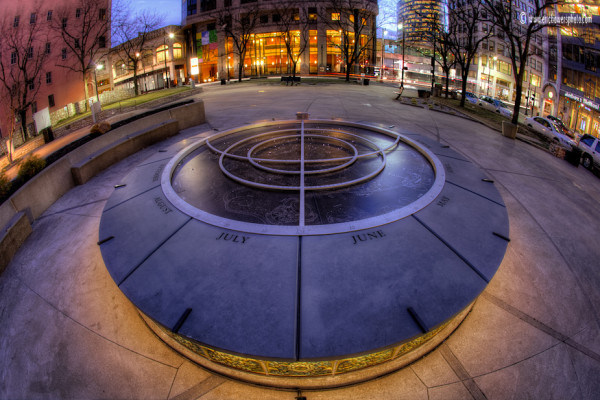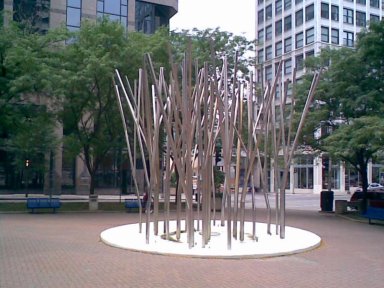Starry-Eyed Surprise in Downtown Oasis
Park/plaza, Celestial Flyways, Oppenstein Bros. Jewelry, Jewish community, Oppenstein Bros. Foundation, Power and Light District

When considering how to create a public square in the reviving downtown area, artist Laura DeAngelis envisioned something ambitious: a thematic representation of the region’s natural life. Sounds like a tall order for a tiny park in the middle of the financial district? Maybe. But the finished product of Oppenstein Brothers Memorial Park is not a cold, high-brow piece of unapproachable art. On the contrary, the plaza bustles in the daytime with business lunches and passing pedestrians, exuding warmth and welcome. Dog walkers pass napping homeless men while executives dish over their grocery store salads. The street scenes of life lived play out on the surface of DeAngelis’ Celestial Flyways concept, sure enough bringing together the movement of natural life with the motion of the city.
The park had been a hot spot before—its once-recognizable Rain Thicket fountain was built in 1980—at a time when its namesake still stirred a sense of reverence among Kansas Citians. Louis Oppenstein was a successful jeweler from Denver who worked to support his mother and six siblings after his father’s death, eventually opening a family business in Kansas City in 1902. The Oppenstein Brothers jeweling store turned big profits, allowing Louis to invest in real estate and grow his wealth. He was worth millions, but remained publicly modest. He instead invested wealth across the city, particularly and personally involved in efforts for the Jewish community. His legacy of investment continued after his death in 1938, with the establishment of the Oppenstein Brothers Foundation.
Unfortunately the investments of figures like Louis Oppenstein were failing to save the struggling downtown loop in the decades leading up to the turn of the 21st century. For years the buildings to the south of the park were invariably vacant. The residential core had long since moved out into the greater metropolitan area. The question of how to revive the once-thriving district hung heavy over developers’ heads.
Things were looking up in 2007, when operations began in the nearby Power & Light District. Businesses, bars, and most importantly people were quickly returning to the area, creating more foot traffic than had been seen since the 1960s. It was the perfect time to revitalize the Oppenstein Brothers Memorial Park, just a block away from the action.
Local artist Laura DeAngelis and Davidson Architecture + Urban Design were enlisted to create public art in the patch of park. Her design includes the rendering of 16 indigenous birds’ migratory patterns. To the common visitor, the arching inlays might not look like much more than a chaotic trolley track intersection. But DeAngelis was quite deliberate in her selection of bird species that relate to the world above the skyline. The artist also selected landscaping using native prairie plants.
Tying the natural environment into the urban core, the park takes on a more symbolic purpose as an area of preservation amongst the downtown landscape. Just as the redeveloped and rehabbed buildings that surround the park preserve a built history, Oppenstein Brothers Memorial Park preserves a natural one.
If this sounds like a highly conceptual description of a city park, it gets weirder. Replacing the Rain Thicket fountain in the center is perhaps one of the most unique works of public art in the city. An anaphoric star disk[1] sits as the focal point of the park. Covered with mythological characters and constellation designs, the functional disk can be rotated to reflect the correlating astronomical landscape to a specific date and time.
Before writing DeAngelis off for being a bit starry-eyed, consider her contribution to downtown redevelopment. The redesigned park was dedicated in April 2008, and since then has been consistently populated with all walks of downtown life. Though many might mistake the anaphoric star disk for a well-decorated sitting spot, its message is still felt in the park, on a nice day, when office workers step out into the slice of nature and breathe the open air in a now-crowded downtown.











